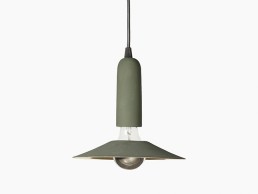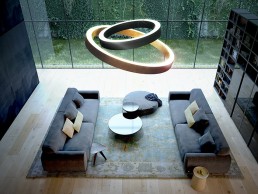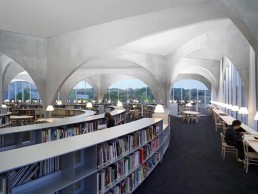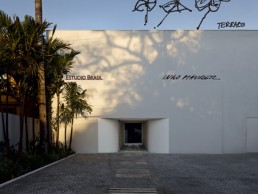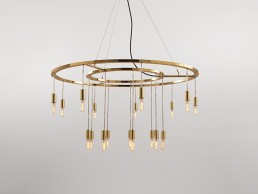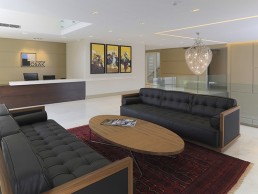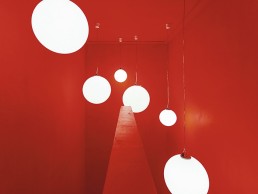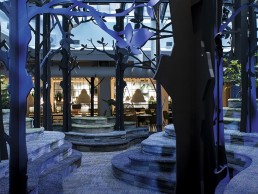Klove Grasshopper
The Grasshopper is a great example of Klove’s take on a mid-century modern design. Muted sepia and warm wooden tones are highlighted by edgy rose gold details making it a truly contemporary lighting piece. An India-based boutique luxury studio, Klove specialises in custom lighting solutions.
Apparatu Zero
On show at this year's Downtown Design is ZERO, designed by Xavier Manosa. A simple pendant lamp with a unique twist: the lamp holds the shade in place - the three components of the lamp (shade, lamp-holder and rose) are handmade in stoneware in Apparatu’s pottery workshop in Rubi, Barcelona.
Panzeri opens first branch abroad
(Germany) - The Brianza-based company will open a space in Munich dedicated to products and design in the core of the German industry.
Panzeri chose Munich to oversee Germany, one of its key markets for export. The branch of the Biassono company will open in November, in the central and prestigious Karlsplatz with the goal of improving the brand's positioning and distribution in Germany. Panzeri has chosen to create an ad hoc company with a local partner, Panzeri&Partners to achieve these goals.
Its presence in Germany is consistent with the internationalisation of Panzeri, also reiterated in recent interviews issued by Federico Panzeri, Export Manager. The family business continues to increase sales abroad (Austria, Germany, USA, Canada and Russia), without losing its appeal in Italy.
Panzeri lighting products 'Made in Brianza' can be found in the German subsidiary, a dedicated location of over 300sqm, creative design and stylish furniture and accessories, as well as requesting design consultancy and lighting technology. It serves as a space for integration for different categories of professionals in the field of lighting and interior design.
Monaco was chosen because of its role as a point of reference, including all of Bavaria, in the field of lighting in Germany. The German vision of the corporate web site, which is still the main tool used by Panzeri to communicate, will be online by the end of 2016 to support the new branch.
Daan Roosegaarde receives Design Innovation Medal
(UK) - Dutch designer and innovator Daan Roosegaarde was awarded the Airbnb Design Innovation Medal during London Design Festival.
The recipients were introduced at Exchange Square, while the official ceremony will follow at Tate Modern's new Switch House extension in the evening. The Design Innovation Medal, supported by British Land and Airbnb, celebrates the achievements of designers who are making a significant difference to lives through their innovation, originality and imagination.
Roosegaard is best known for his interactive designs which connects people, technology and space to improve the quality of daily life in urban environments. Roosegaarde has been driven by nature's gifts such as light emitting fireflies and jellyfishes, since a young age.
His fascination for nature and technology is reflected in his iconic designs. Roosegaarde founded Studio Roosegaarde in 2007 in Rotterdam, where he leads a team of designer, engineers and technicians to develop ‘Landscapes of the Future’ smart sustainable prototypes for the cites of tomorrow.
His award winning projects include ‘Waterlicht’, a poetic experience which shows the force of water and its rising levels; ‘Smart Highway’, sustainable roads that charge during the day and glow at night. His acclaimed ‘Smog Free Project’, the largest outdoor air purifier in the world which turns smog into jewellery, is about to start its grand China tour this month.
Roosegaarde has been named Young Global Leader at the World Economic Forum and Artist of the Year 2016 in the Netherlands. He has won the INDEX Design Award, the World Technology Award, two Dutch Design Awards, the Charlotte Köhler Award, and China's Most Successful Design Award.
He exhibited at the Rijksmuseum Amsterdam, Tate Modern, Tokyo National Museum, Victoria & Albert Museum, Le Musée des Arts Décoratifs Paris, and various public spaces in Europe and Asia. He has recently been selected by Forbes and Good 100 as a creative change maker.
For 2016 the award recipients have again been chosen by an illustrious selection including Dr Martin Roth (Director, V&A), Paul Thompson (Rector, Royal College of Art) and Justine Simons (Head of Culture, Mayor of London) and Tony Chambers (Editor-in- Chief, Wallpaper*).
Winners have been selected from a range of design disciplines, chosen for their exceptional contribution to their design domain. Designers and architects such as the late Dame Zaha Hadid, Marc Newsom, Thomas Heatherwick and Peter Saville have been among the renowned London Design Medal.
Daan Roosegaarde, Designer and Innovator: “Design to me is about improving our daily life, it is not about creating another lamp or another chair. It is an honour to receive the Medal today and to celebrate the importance of innovation here in London.”
Luceplan's Costanza celebrates 30 years
(Italy) - Luceplan celebrates Costanza, a story thirty year success story.
For this occasion, Luceplan will produce a special model of Costanza with an exclusive finish, in a limited numbered edition of 1,000 pieces, signed by the designer, for both the table and floor versions. The brushed bronze finish of the structure of Costanza is entirely done by hand by specialised craftsmen, making every piece unique.
Costanza was created in 1986 thanks to the brilliance of Paolo Rizzatto, the internationally renowned designer and co-founder of the company. It was a simple but sparking bit of intuition, to rethink the classic shade lamp combining the simplicity of its lines with innovative technological solutions.
A very advanced project for the 1980's, thanks to the introduction of two innovative elements: the first had to do with the material of the shade, a polycarbonate sheet that replaced traditional materials, facilitating transport thanks to the breakdown of the lamp into parts, with the possibility of assembling the flat sheet with a system of snaps, without any need for a frame.
The second innovative feature had to do with how the lamp is turned on and off: light emission is regulated by an electronic touch dimmer, performing on-off and intensity adjustment functions with a simple touch of the finger, exploiting the conductive properties of the human body.
The design is that of an archetypal lamp, combining simple, traditional, familiar forms: the square of the base, the straight line of the slender stem, the volume of the shade that evokes the form of the circle. The object comes to life from the relationship between two almost opposite formal worlds: one solid and symmetrical, the other light and surprising, in a fusion of inimitable poise and natural aplomb.
The first entry on the timeline of the collection is the Costanza family, in its floor, table, wall and suspension versions, followed in 1992 by Costanzina, the mini-version of Costanza. The family then expanded with new models, each with its own particular beauty and ability to enhance any type of space, including outdoor zones. Starting in 2014 the Costanza family has been updated with LED technology, becoming even more versatile and guaranteeing remarkable energy savings.
In 2013 Costanza evolved with a new range of colors, organized in two families of hues for the shade, each with five original colours that bring out the qualities of the matte surfaces. First came the Radieuse collection: forceful, dynamic colours in pure tones. Primary Red, Liquorice Black, Petroleum Blue, Bright Yellow, Cement Gray and the indispensable White. The next development was the Mezzo Tono collection, a soft, painterly line of pastel shades. Light tones that stand out for their discretion and their welcoming warmth: Alchemy Green, Mystic Rose, Fog White, Powder, Hazelnut.
A piece with a unique, striking design, Costanza is now an icon found in millions of homes around the world, and used by leading designers to create prestigious contract, hospitality and residential solutions. Thanks to its originality and the wide range of models and colors, Costanza responds to the widest range of technical lighting needs, for lighting design that is always different, and always in step with the times.
Ingo Maurer opens São Paulo showroom
(Brasil) – Ingo Maurer’s new São Paulo showroom by FAS Iluminação opens at the end of September.
The space is expected to be as unique as Ingo Maurer’s temporary exhibitions in Milan, providing visitors and residents of São Paulo a special spot to experience Ingo Maurer’s work in a permanent space.
Estúdio Brasil is run by FAS Iluminação, but has been designed in close collaboration with Ingo Maurer and his team. As in Munich and New York, the two showrooms managed by Ingo Maurer directly, visitors will find a great number of unique objects, among them a Golden Ribbon and two Porca Miseria.
One of them is a special version with reference to Brasil's stunning nature, which Ingo Maurer created in early summer, expressing his love for the South American country. The arrangement of the complete display was planned by Ingo Maurer and staff members Axel Schmid and Hagen Sczech.
By Beau Dimple installation
When it came to lighting the 2017 Pronovias bridal fashion show, lighting designer David Monguet knew he needed something extra, that show stopping moment... And so, making it's onstage debut, we introduce ByBeau's Dimple.
Marriage is a moment that stands as a symbol, a union, a meeting of minds. Creating that ‘moment’ is fittingly collaborative, as families unite and artists of all disciplines work towards that special day… And at the centre of it all, the dress.
The launch of the Pronovias 2017 bridal collection in Barcelona, Spain, reflects what a wedding dress symbolises; a meeting of minds distilled in a moment of magical intimacy, suspended amidst a breath-taking spectacle. Working to create a beautiful backdrop that enhanced and showed off the stunning wedding gowns, the lighting for the show saw talents and the meeting of minds from lighting designer David Monguet, Beau McClellan of ByBeau, Rebeca Sanchez of LEDScontrol and Sarah Cortes of Studio Cortes.
Working together, the team looked to capture the emotion of ‘that’ moment, ‘that’ dress underneath a shimmering sky of light that makes use of ByBeau’s Dimple installation - a modular lighting system designed by Beau McClellan and manufactured, built and tested, in full-scale for pre-programming ahead of the show, by Climar at its HAB50 R&D facility in Portugal.
Born from contrasting inspirations, Dimple is an interpretation of both dramatic engineering spectacle and the most intimate of emotions.
Dimple's roots are in McClellan’s earlier project Reflective Flow, comprised of hand-ground crystals, each shrouded by concave glass and finished with a unique reflective coating. Invisible behind this glittering body was a state-of-the-art system of individually controllable LEDs. Each crystal was fully independent to create shifting tides of colour, shape and light; when illuminated the reflective surfaces become either fully or semi-transparent, bursting alive with waves of light in an unmatchable expression of movement; a unique sensory expression.
Dimple incorporates similar upgraded features, a plug and play RGBW chip, specially designed for its unique palate of colours and to give total control over each unit – giving true interactivity; with different moods and ambiences reactive to a range of stimuli. Different temperatures and movements are interpreted and expressed by Dimple to create an art installation of unlimited variability. When turned on, the two-way mirror-coated finish unveils an extra interior hand-blown glass ball.
Speaking with darc about the collaborative process for the Pronovias show, McClellan said: “The introduction with Pronovias came through Rebeca, she’s an old friend and we have worked on other installations together over the years. When she got the phone call from Pronovias’ lighting designer David Monguet, she immediately thought of Dimple and it moved from there really.
“I had never really thought about Dimple being used on a stage, so in that sense this project was really unique. Dimple was originally designed as a bespoke piece but the fact it can also be used as an amazing set piece or in its simplest form as a single pendant light, really shows its potential.
“The brief was the sky, in keeping with the title of the show, and we had about a month to pull everything together. The number of Dimples required kept increasing - we started with just 500, then it jumped to 1,000 and we ended up with 1,500 for the final installation. At this point we hadn’t ever designed Dimple as a rental kit so we also had to design flight cases so it could be transported safely and built up quickly. We really had to consider how it was all going to work logistically.
“Once we had decided on the number of Dimples required, we then had to look at what was required for the catwalk and considered lots of different designs. Getting it right and making a final decision before we shipped to the venue was key, as we didn’t want to have to start changing things once on site - also, Rebeca required a final full 3D model for progamming. Everything had to be built at Climar's cutting edge R&D department HAB50 in Portugal first. This is also where the hanging structure for the Dimple installation was developed.
It was pretty full on and we had to work hard to pull it off, but we got there.”
The Dimple installation created specifically for Pronovias, reflects the brand’s message of luxury and glamour. The idea of using a light installation was something very new for a catwalk show, as the lighting is usually hidden in the ceiling, so for McClellan, this project has really opened up the possibilities of incorporating Dimple on stage.
At the start of the fashion show the audience were presented with the Dimple installation at stage level, hovering just a few centimetres above the mirrored catwalk floor, before being lifted up so the dresses could take centre stage.
“A couple of things happened during set up that made us realise the full potential of Dimple,” continued McClellan. “When we started working with David we discovered that Dimple’s mirror-coated finish absorbs light as well as reflecting it, so this brought a different dimension again – it became something really spectacular as David used moving heads to externally light the Dimples so we could change the colour – what could be achieved by combining all the different elements was amazing.”
Having been awarded a Design Plus Award at this year’s Light + Building in Frankfurt, and Best Decorative Lighting product at the 2015 darc awards, this latest collaboration with one of the top international bridal designers, is further reinforcement of Dimple’s unique qualities and versatility.
“Dimple has been a massively collaborative product to realise,” said McClellan, “and here again, for Pronovias, it required multidisciplinary management to involve specialists like David Monguet and Studio Cortes to create the magnificent stage lighting and set design.
All of this working towards capturing the emotion of the moment, stunningly demonstrated as each beautiful dress was presented underneath a shimmering sky of Dimple stars.”
www.linkedin.com/in/davidmonguet
Plumen 003
The Plumen 003 - created with sheer beauty in mind. Not intended to blend into the background, the lamp's creator Nicolas Roope gives darc the inside story on what could be, 'the most beautiful lamp in the world'.
What would the world’s best lamp do? This is the question British design company Plumen found itself asking five years ago when it began work on its latest lamp release - the 003. The answer? “It would make you and everything around you, look beautiful.”
Reinventing the future of lighting, Plumen has launched a ‘shade in a bulb’, a hybrid, new format of lamp that tames the glare of LED light while putting the magical flame back in. Giving a warm, cosy glow around the sides and a bright clear light on the surface below, the 003 is a practical yet beautiful light. Plumen’s Co-founder and Creative Director, Nicolas Roope takes darc back to the beginning…
“When we launched the Plumen 001 we wanted to create the first beautiful low energy lamp because, quite frankly, every efficient lamp up until that point was boring, ugly and utilitarian. We made the first designer lamp in the low energy category and it worked very well.
“When we started with the 003 project five years ago we knew we’d have to set the bar higher. Going as far as creating the most attractive LED lamp would have been an easier goal, but we wanted to go further.
“The reason Plumen started was to try and inspire the general public to choose efficient lighting technology through the allure of beautiful design. We’ve sold over half a million products but have only really scratched the surface. The reason being, that the traditional filament lamp is such a fantastic product and lighting experience that it’s an incredibly hard act to follow.”
Having spent two years researching developments in LED technology and how different brands were trying to recreate the beauty of incandescent lighting, designer Claire Norcross worked with the Plumen design team to shape the lamp envelope and element silhouettes.
“We wanted to improve the look, the light experience, its ‘real world’ efficiency, as well as the standard benefits of moving to LED,” says Roope.
At Plumen the idea is to revolutionise formats and as such R&D takes a very different course and really starts at the fundamental questions about how different technologies, materials and formats interact. “What we’re trying to find is the kernel of something really interesting and powerful at its essence, and therefore something that can scale and range across products whilst maintaining a certain quality of look and lighting experience.”
While previous Plumen products have worked within the scope of existing production methods for lamp manufacturing, with the 003 some elements needed to be sourced from other sectors because of the unique materials and processes. One of the things the team kept going back to when contemplating the beauty of the incandescent was how the light really appears to burn in the heart of the lamp. “When you read old quotes from around the times of the Edison lamps you realise how magical and mesmerising they were (and still are),” says Roope. “Many described how the glowing elements seemed like it burned like a small slice of the sun.”
As such, a principle part of Plumen’s ambition was to create something that felt like a really convincing element that appeared to burn and that convinced the eye that it was alive. “Many still complain of the coldness and flatness of LED and our thesis believes this is because, on inspection, LED lamps don’t feel magical.
“We got to a point where we’d created metallic elements that were incredibly beautiful but lacked something. The surface needed to spread the light across, so the silhouette of the element shape would appear more full from a distance. The reflected light lacked texture and some of this illusive magical quality we wanted to create. We started playing with making impressions onto the parts, which on one hand drew the light out across the surface and on the other created a very ornate and interesting effect on the reflected light.”
It was at this stage that jewellery designer Marie-Laure Giroux worked with the Plumen design team to fine tune the element faceting design and colour and material surface texture.
Now jewellery might seem like a very different discipline to lighting design but it’s much closer than you think according to Roope.
“A jeweller must work with many of the same qualities of light as we do in lighting. Reflection in both metals and precious stones and the optical effects refraction and internal reflection have in cut stones. A great jewellery designer manages all these qualities, working in the different colours and textures of each material. So a jewellery designer IS a lighting designer. And as we wanted to create some magic in our element, involving a jeweller in the production made a lot of sense.”
While the look and feel of the 003 lamp were of upmost importance to Plumen, creating the ‘best lamp in the world’ meant delicately balancing aesthetics and technology in order to make a product that progresses on as many fronts as possible. “The 003 had to look as fantastic as it could but also perform as well as possible, and of course be delivered at a relatively affordable price,” says Roope.
“These issues are often in tension but it doesn’t mean they have to fight each other,” continues Roope. “We’ve seen many products come to market that look great but don’t work as well or the other way around. If you want to tick every box it’s a tougher brief but you can get there, it just takes more time, more exploration, more imagination, more trials. What I love about the Plumen 003 is how it’s a beautiful but very useable product that reconciles looks and use perfectly.”
So how does the 003 work? How has Plumen balanced aesthetics with technology? The light output from the LED chip, which is mounted in the 003’s lamp base is managed by a structured optic that carries light through the centre of the metallic elements. Some of the light is kicked off by refracting sections of the beam onto each metal element. The light is also bounced on the golden faceted material, providing an indirect light source to the user that is both lower in intensity and also warmer in colour than the source, creating a beautiful image and a very flattering light on skin, much like candlelight.
The majority of the lumens however, make it out of the end of the optic and flow onto the surface beneath, providing an even 2,700K light – a really balanced warm white light that illuminates food, drinks, books and so on.
“So it provides the general ambience of a dimmed incandescent with the bright, task orientated spot,” says Roope. “And it creates a really strong architectural accent light with a hard-working spot, so will allow specifiers to create a completely different environment and lighting effect.”
Describing the lamp’s construction and method for distributing light as ‘unique in LED products', Roope says: “We’ve seen most LEDs settle into using either general diffusion or optical distribution in their approach to taking directional light sources and making them omnidirectional, and of course with filament LEDs spreading the chips out themselves to enable the light to spread out. We have taken a unique approach that combines optical control with reflection that has been resolved by the way we use the optics as structural components to hang the elements so no shadows are cast.”
With so much choice in the ‘designer energy saving lamp’ category, Plumen has created a fixture that is much more luxurious in both its look and effect in comparison to other products in the market. “We wanted to do something spectacular so allowed the costs to follow this ambition,” says Roope. “If the 003 goes as well as we hope, then we will look to launch different colour and material variants to create very different looks and experiences. And we’ll also look at adapting the construction into many different formats to work across different styles and interior treatments.”
Reflecting on the project, Roope describes the most significant part of the journey, telling darc: “I think it was the first time I saw all the elements coming together. There’s been a full team working together on this and those long runs in the dark are challenging. You’re sharing a vision that no one else can see yet and it’s their trust in you alone that keeps things moving. But then, when things fall into place and everyone can start to see where it’s going it’s a huge boost.
“When we started firing up the first working prototypes it was a similar situation, we could see how special the feeling was from our theoretical assumptions and beliefs. The first time we set the final production models properly - above our meeting table - was for Prince Andrew’s visit to Plumen in the spring of 2016. It was wonderful sharing our journey for the first time with the Duke, but the atmosphere in the room the 003 created was incredible and really created a positive conversational atmosphere. It was at this moment I knew we’d created something special.”
Santa & Cole Vaghe Stelle
The Vaghe Stelle chandelier was originally created for Brasserie FLO in the early 80's by Santa & Cole, in collaboration with renowned architect and designer Antoni de Moragas i Spa. Re-issued for 2016, as part of the brand's 30th anniversary, darc takes a closer look at this significant historical design.
Founded in 1985 by Nina Maso, Gabriel Ordeig and Javier Nieto, Barcelona-based lighting brand Santa & Cole has, over the last three decades, developed an impressive catalogue of contemporary and historic lighting by Spanish and internationally recognised designers.
As part of its 30th anniversary celebrations, this year, the company has reissued its Vaghe Stelle chandelier, originally designed in collaboration with renowned architect Antoni de Moragas i Spa.
The son of architect Antoni de Moragas i Gallissa - one of the leading figures in the architectural renovation of post-war Spain, and one of the cornerstones of modernity - Antoni de Moragas i Spa has won several awards for architecture and interior design during his career and has, throughout, combined his work as an architect with teaching, and interior and furniture design.
Reflecting on the Vaghe Stelle's roots, he tells darc how the initial brief for the chandelier arrived when he received a commission from restaurant owner Jean Paul Bucher, to convert an old textile warehouse in Barcelona into a restaurant – the Brasserie FLO.
“I was in charge of the overall design of the restaurant and our relationship was a positive experience from the outset,” Moragas tells darc. “He was very open to my proposals, apart from the lighting initially. My design included a series of white glass globes to which Bucher said: ‘Monsieur Moragas: pas de boules’ (Mr Moragas, no balls). And so, he provided the solution – 'create the lighting yourself.' That was how the Vaghe Stelle came to be.”
Inspired both by medieval architecture and the designs of Viennese Secessionists Joseph Maria Olbrich and Adolf Loos, Vaghe Stelle also has literary roots, taking its name from Giacomo Leopardi’s poem Le Ricordanze, which refers to the Vaghe stelle dell’Orsa (the vague stars of the Big Dipper).
Commenting on the reinvention of the Vaghe Stelle for today’s market, Santa & Cole's Nina Maso tells darc: “We had to adapt the fixture to the requirements of new markets and one of the main challenges was to simplify the lamp assembly and installation process. It is a simple design that boils down to the essentials - this is what makes it a timeless piece.”
Maso strongly believes that a designer is the guardian of the vision of their work and as such, when it came to bringing this fixture back to life Moragas worked closely with the Santa and Cole team to ensure Vaghe Stelle was released according to his vision and specifications.
“A designer should always create products that are not too prescriptive and can live well in a variety of settings,” says Moragas. “Vaghe Stelle was never designed to be fashionable.”
And because of this, the chandelier is still suited to the same kind of projects it was initially intended - whether it’s a lobby of some kind, restaurants or public spaces - even homes, thanks to its warmth that can create a very welcoming ambience.
“The Vaghe Stelle light was first made in the 1980s and back then it was a practically unknown design,” adds Maso. “Part of our work at Santa & Cole is to rediscover and recover historical designs to put them back on the market. The reason why Vaghe Stelle is in our 2016 catalogue is because we believe that new generations will understand and appreciate this magnificent design. We want to give it a second life.”
“Santa & Cole has a catalogue of design ‘classics’ and I am delighted my light has been added,” continues Moragas. “It’s a huge honour and I hope it reflects how I approach all of my work in design and in architecture. Things should stand the test of time and it would never occur to me to have one ‘signature design’. I design with the aim of answering a question that I put to myself with each different brief that I take on.
“Light in my projects plays the same role as colour… It is the only thing that can be drawn. I would say my use of light is cinematic.
“Today the world is a democratic place.There are more people, more ideas are shared and there is greater awareness about design. The re-edition of Vaghe Stelle is an example of that.”
Osak, Turkey
Through this project, ARTI Interior Architecture wanted to reflect Osak’s personality as a Turkish building company with a long history focussed on providing quality service with cutting-edge technology, and as such approached it with function and elegance at the forefront of its design.
Also working as a reflection of Osak’s vision for its employees and work, lead interior designer Ipek Toplu Bilgic worked closely with architectural group Hatirli & Hatirli to create a concept capitalising on transparency, light and reflection.
Set back from the adjacent avenue, the building’s most noticeable external feature is the well-lit entrance that creates an interesting and inviting welcome at first glance. With different materials all coming together in the front façade, the building stands as an architectural statement that reflects the ambition and capabilities of the firm housed within.
Bilgic asked three partners to join her in this project; a Turkish stained glass artist Zehra Talay, a Turkish painter Funda Iyce, and lighting supplier Tepta, which supported Bilgic in creating a unique experience through Brand van Egmond lighting sculptures.
“I had used Brand van Egmond sculptures on two residential projects before, and I chose them again for this office because of their sculptural qualities,” commented Bilgic.
The Hollywood chandelier and Crystal Waters suspension lamp seen in both galleries were chosen for their iconic character and transparency.
Having designed both the interior and exterior scheme of the office, Bilgic said: “I placed Crystal Waters at the glass entrance. At night, Osak leave the lights on to enhance the night view of the building. Crystal Waters creates a strong sculptural image towards the whole exterior of the front façade.”
Holding light as the most important aspect of any interior, Biglic’s view towards lighting in an office project emphasises its significance in terms of personal impact. “Lighting totally changes the ambiance of an interior. If a working area doesn’t have the right light, it decreases the motivation of employees, especially in areas where the light should be more homogenous than bright.”
Brand van Egmond's sculptural pieces selected in a collaborative effort between ARTI and Tepta, work here to emit notions of luxury, reflecting the style of Osak's work and what it aims to achieve for its employees and clients. Decorative lighting is key in this portrayal for Osak's staff to be surrounded by what they aim to create.
SmartDigital, Germany
Berlin-based IONDESIGN focuses on 3D design across disciplines, connecting interior design and architecture as well as other forms of physical and digital design. Aiming at the timeless utility in design, the SmartDigital office in Berlin is no exception to the studio’s focus in its flexible floor plan and definitive lighting scheme.
Excluding the space on the ground level, which is now occupied by the SmartDigital office, Wall was already using a large part of the building, so IONDESIGN was tasked with connecting the new office to the rest of the company headquarters. As such a vibrant colour, the neon red entrance from the street to SmartDigital demanded a large amount of light; Slide’s Globo Hanging pendants were selected to bring the space to life, and stand out against the red backdrop.
The entrance from the street was closed off and a staircase was opened again to access the new office space from the first floor.
The red neon entrance opens into the bar area where Muuto’s Unfold pendants hang out in a playful yellow, contributing to the lively atmosphere that IONDESIGN set out to achieve, adding a splash of colour to the interior while emitting an atmospheric light. This lively part of the office is placed in the most public area to help partition the open plan structure, highlighting the role decorative lighting plays in departmentalising this popular type of spatial office design.
SmartDigital’s yellow and red neon colours were inspired by the ground floor venue’s surrounding road traffic, and help to create a lively atmosphere while increasing the wellbeing of employees.
King, Sweden
King, creator of Candy Crush and one of the world’s leading game development companies, appointed Adolfsson & Partners to work with lighting practice ÅF Lighting on finding nature a home within its new office, K36, in Stockholm, Sweden.
Originally designed by German architect Cyrillus Johansson, the building in which the K36 office resides is a striking brick structure influenced by North German brick architecture in the turn of the 20th century. Since its construction in 1931, the building has been home to numerous professions, from a pastry-shop to a Swedish bank. Now named after the office’s address, Kungsgatan 36, K36 stands at the intersection of two of Stockholm’s major streets, surrounded by a vibrant crossing in a district that now works as a melting pot for the media industry.
Swedish interiors and building company Adolfsson & Partners worked in close collaboration with lighting practice ÅF Lighting and Czech interactive video technology experts 3Dsense to develop functional and ambitious concepts for turning light into something unique.
Adolfsson & Partners was responsible for the interior design and decorative lighting scheme, while ÅF Lighting was responsible for the architectural lighting design, and developed interactive elements with 3Dsense.
Adolfsson & Partners recently worked for King on creating its other office at Sveavagen in Stockholm, which resulted in a unique and inspirational place full of colour and creativity with graphics from King’s world of games.
Founder of Adolfsson & Partners Hans Adolfsson commented on how the King offices differ: “In comparison to the other office, K36 was developed for a team that creates more realistic looking games and therefore the concept of the venue follows that style.” For K36, the inspiration came from Swedish nature – a place to be free in both mind and spirit.
Working at King, where teams change frequently depending on the project, the office space needed to be flexible and provide multiple places suited for all types of operational methods. At the same time, Adolfsson & Partners had to focus on how King’s world is driven by creativity and playfulness. As a company that constantly uses energy and power to search for new ideas, King needed an office to match that drive.
K36’s interior from the entrance on ground level to the lower level working zones is an extraordinary combination of playfulness, stimulation and calm. “With a strong vision from Adam Schaub, King Studio Manager, we took this project to heart and came up with a concept that has its roots in the Swedish forests,” said Adolfsson. “We decided we wanted to apply the same inspiring and calming effect that you get from spending time in natural surroundings, to the new King office. From the moment you step inside the doors of K36, you are struck by how this concept goes to the next level.”
The central idea to ÅF Lighting’s scheme was to allow the light to create an inspiring environment that felt natural and enhance feelings, where darkness would also be part of the experience. The light was to be largely based on actual activities and work done in the office as an honest interaction with nature.
The reception wall, set off by Muuto’s E27 pendants, is entirely covered in treated Norwegian lichen, a type of moss, immediately setting the tone for growth and natural inspiration that progresses throughout the entire office.
Head of Design at ÅF Lighting and project Design Manager Kai Piippo commented: “This foam-like wall actually made it very difficult to fit lights. With the building construction time being only six weeks, we didn’t have much time to question anything, so we had to think fast in finding solutions.”
Walking past ice hockey tables and pinball rooms with Zero’s Par table lamps, NUD Collection’s BASE lampholder and textile cables lead employees down the spiral stairs to the working space, a setting enhanced by painted plywood silhouettes of trees. “Combine that with soft woven fabrics and the result is both organic and sculptural,” said Adolfsson. “This works well with the colour theme of warm green and different shades of grey on both floors, walls, textiles and tables.”
Stepping into the working space at the lower level, employees are greeted by greenery where the concrete jungle of a city meets the Swedish forest. Beneath an atrium skylight, a digitally interactive forest uses a combination of Crestron light control solutions with the flow of natural light to dark from overhead to create this organic, digitally innovative scene that serves as a meeting hub, a lunch spot or simply to spark imagination. The forest uses lighting design to reflect the changing seasons, so at the touch of a button, wintry ice can appear to crack in the river underfoot, or leaves turn green in an abundant summer scape.
Surrounding this indoor forest in an open plan fashion are the office’s 121 work spaces, each equipped with custom desk lamps manufactured by ateljé Lyktan, designed by Mia Cullin at Adolfsson & Partners in collaboration with ÅF Lighting. “Individuals can adjust lighting levels to their own personal taste, and this has shown to increase people’s well-being,” Adolfsson told darc.
Employees can then walk through the forest to reach the kitchen and dining area where Moooi’s Salago pendants are suspended above smaller tables, and Frama’s E27 pendants are arranged in a linear fashion down the main long table.
The office also houses fourteen private meeting spaces, where Gubi’s Grossman Cobra floor lamps provide adjustable and personable illumination, continuing the theme of natural adaptability in office design and employee development. In further encouragement of its employees’ natural growth and progression, K36’s library serves as a space for people to learn and develop as natural beings under the illumination of Normann Copenhagen’s Amp, Lightyears’ Carvaggio table lamps and Wästberg’s Studioilse w084f floor lamps.
“When designing an office, it is important to create a better and more human-centric lighting solution,” said Adolfsson. “People are spending more time in these spaces so the lighting needs to meet the demands in terms of flickering, glare and so on.” With telephone rooms housing Lampe Gras’ No2010 and No213L wall lamps, and lounge areas for well earned rests, K36 is human-centric through to its core.
The project stayed true to its original mission to create a unique office for King, a company that wants its employees to think about something other than work 25% of the time. Its lighting scheme is carefully thought out by humans, for humans, and goes to great lengths to provide stimulating comfort for people who create a global form of entertainment. As an artificial design made possible by creative technology, K36 holds an immense amount of the natural world within its manmade walls, serving as a reminder of the inescapable relationship between humans and nature.

